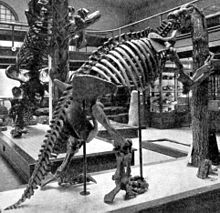- Megalonyx
-
Megalonyx
Temporal range: late Miocene to PleistoceneMegalonyx wheatleyi skeleton. Scientific classification Kingdom: Animalia Phylum: Chordata Class: Mammalia Superorder: Xenarthra Order: Pilosa Family: Megalonychidae
Gervais, 1855Subfamily: Megalonychinae Genus: †Megalonyx
Harlan, 1825Species - †M. matthisi Hirschfeld & Webb, 1963
- †M. wheatleyi Cope, 1871
- †M. leptostomus Cope, 1893
- †M. jeffersonii Desmarest, 1822
Megalonyx (Greek, "great claw") is an extinct genus of giant ground sloths of the family Megalonychidae endemic to North America from the Hemphillian of the Late Miocene through to the Rancholabrean of the Pleistocene, living from ~10.3 Mya—11,000 years ago, existing for approximately 10.289 million years.
Contents
Taxonomy
The generic name Megalonyx was proposed by future U.S. President Thomas Jefferson in 1797, based on fossil specimens of what later came to be called Megalonyx jeffersonii that he had received from western Virginia. His presentation to the American Philosophical Society that year is often credited as the beginning of vertebrate paleontology in North America. However, Jefferson's name has no validity in zoological nomenclature, and Megalonyx was first formally named by Richard Harlan in 1825.[1]
Biogeography and phylogeny
Megalonyx evolved from ancestors that island-hopped across the Central American Seaway from South America, where ground sloths arose, prior to formation of the Panamanian land bridge. Its appearance in North America thus predates the bulk of the faunal exchange between North and South America. Its immediate predecessor was Pliometanastes and its closest living relatives are the two-toed sloths (Choloepus).
Range
Megalonyx ranged over much of North and Central America.[2] Their remains have been found as far north as Alaska[3] and the Yukon.[4]
Parental care
Ongoing excavations at Tarkio Valley in southwest Iowa may reveal something of the familial life of Megalonyx. An adult was found in direct association with two juveniles of different ages, suggesting that adults cared for young of different generations.[5][6]
Species
M. leptostomus
M. leptostomus was named by Cope (1893). This species lived from Florida to Texas, north to Kansas and Nebraska, and west to New Mexico, Nevada, Oregon, and Washington.
Fossil distribution
- Taunton site, Adams County, Washington. est. age ~3.4—3.3 Mya.
- Wild Horse Butte aka UO 2396, Owyhee County, Idaho. est. age ~2.7—2.1 Mya.
- Buckeye Creek (UCMP V-93067), Douglas County, Nevada. est. age ~4.4—4.5 Mya.
- Kuchta Sand Pit, Yankton County, South Dakota est. age ~2.9—2.1 Mya.
- Meade's Quarries 4 and 5, Crosby County, Texas est. age ~3.7—1.5 Mya.
- Haile 7C, Alachua County, Florida. ~1.6—1.5 Mya.
- Kissimmee River, Okeechobee County, Florida est. age ~2.3 Mya.
(incomplete listing)
References
Citations
- ^ McKenna, M.C.; Bell, S.K. (1997). Classification of Mammals: Above the Species Level. Columbia University Press. p. 100. ISBN 0-231-11013-8.
- ^ "Megalonyx". Paleobiology Database. http://www.paleodb.org/cgi-bin/bridge.pl?a=home. Retrieved 2011-07-16.
- ^ Stock, C. (1942-05-29). "A ground sloth in Alaska". Science (AAAS) 95 (2474): 552–553. doi:10.1126/science.95.2474.552. PMID 17790868.
- ^ McDonald, H. G.; Harington, C. R.; De Iuliis, G. (September 2000). "The Ground Sloth Megalonyx from Pleistocene Deposits of the Old Crow Basin, Yukon, Canada" (PDF). Arctic (Calgary, Alberta: The Arctic Institute of North America) 53 (3): 213–220. http://pubs.aina.ucalgary.ca/arctic/Arctic53-3-213.pdf. Retrieved 2008-08-16.
- ^ Semken and Brenzel, http://slothcentral.com/?page_id=2
- ^ Semken; Brenzel (2007). "One Sloth Becomes Three". Newsletter of the Iowa Archeological Society 57: 1.
Other sources
- Cope, ED. (1871) Preliminary report on the vertebrata discovered in the Port Kennedy Bone Cave. American Philosophical Society, 12:73-102.
- Cope, ED. (1893) A preliminary report on the vertebrate paleontology of the Llano Estacado. 4th Annual Report on the Geological Survey of Texas: 136pp.
- Hirschfeld, SE. and SD. Webb (1968) Plio-Pleistocene megalonychid sloths of North America. Bulletin of the Florida State Museum Biological Sciences, 12(5):213-296.
External links
- Sloth World: an on-line bibliography
- Sloth Central
- Smithsonian National Zoological Park: At the Zoo - Slow and Steady Sloths
`
Categories:- Prehistoric sloths
- Pleistocene mammals
- Megafauna of North America
Wikimedia Foundation. 2010.



